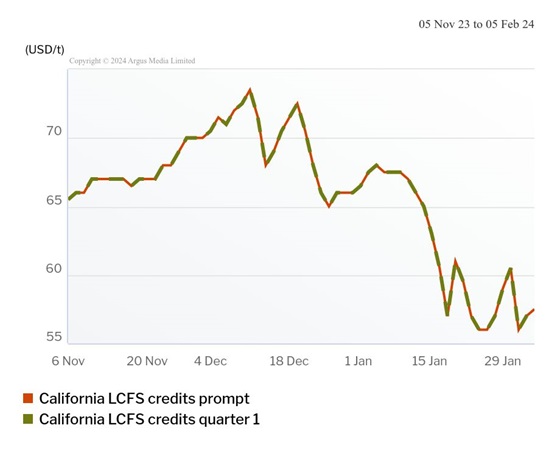Why did R99 differentials nudge higher this past week? And what do California LCFS credits tell us about the market?
Renewable diesel production capacity is set to double by the end of 2027. With this anticipated growth over the coming years, it is critical to ensure fair and reflective values are provided for market participants. As the leading source of global renewable diesel pricing intelligence, this weekly market insight will shine a light on this relatively new and fast paced market and provide visibility to price indicators.
February 5, 2024
California R99 differentials at the head of the pipeline nudged higher on the week. The gains were made amid lower low-carbon fuel standard (LCFS) credit prices, and potentially lower-than-expected local supply, as more renewable diesel (RD) was projected to be online by this time of year. But the overhang of product still persists, with rail extremely back-logged, according to participants. It will take time for the excess volumes to clear up.
California LCFS credit prices remained under pressure, ending the week at $57.50/t and breaking recent records as the $60/t floor got broken two weeks ago. CARB's Q3 2023 data release on 31 January displayed a climb in the bank to 20.6mn t credits. In conjunction with lower D4 RIN credits, the decline in LCFS credits has helped deteriorate renewable diesel margins, which has raised costs for producers. At the US Gulf coast, indicative production margins weakened from 152¢/USG on 26 January to 149¢/USG on 2 February.
California LCFS
(click chart image to view full screen)

Local California supply has also been late to appear. Phillips 66 expects to ramp up toward half of its more than 50,000 b/d RD capacity at its Rodeo plant by April and reach full capacity by July. Also, Marathon will operate its 48,000 b/d Martinez RD plant at 22,000 b/d while working with regulators in response to two fires at the facility in November. Timelines for both of these plants are longer than expected. But Neste could be filling the gap in lower-than-expected local California supply. A maximum of 493,000 bl renewable diesel from Singapore is expected to be delivered to California between 26 January - 9 February. This compared to a maximum 260,000 bl over the same time period last year.

So, although the spot market nudged higher this week, mostly on the back of weaker credits, differentials are still at a five-month low. Many participants are behind on blending, with plentiful offers on hand. Producers that were offline 1.5 months ago, that were running well below nameplate capacity, are just now getting caught up on deliveries, and buyers are having trouble catching up with them. Diesel demand in California has also been low given the amount of wet weather, and seasonally demand should stay subdued until March/April and potentially even May, when agricultural farming demand picks up. Trading for February shipments could be limited as many participants eye the start of 2Q, when demand is expected to pick up and supply to come down.
California R99 Head of Pipe Pricing
(click chart image to view full screen)
.jpeg?rev=-1&hash=2F5CE1E9060A7BC0A8965AA95E150B09)
Argus launched independent price assessments for the California R99 spot market in November, to help drive enhanced visibility. Learn more about these prices.
Explore Argus Americas Biofuels

